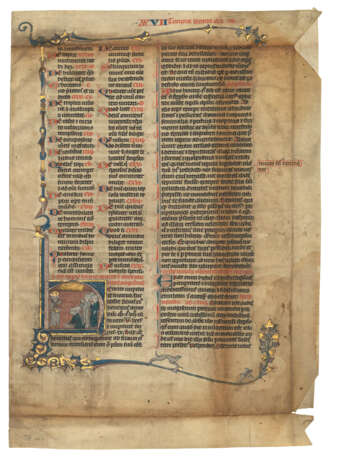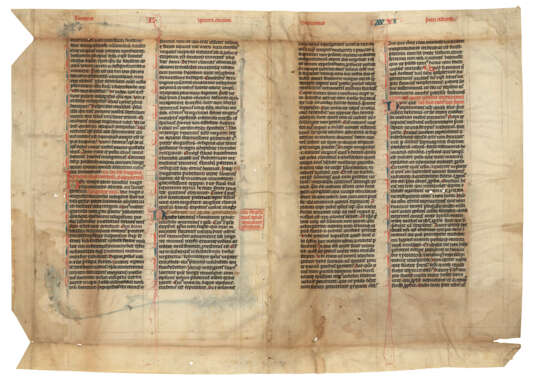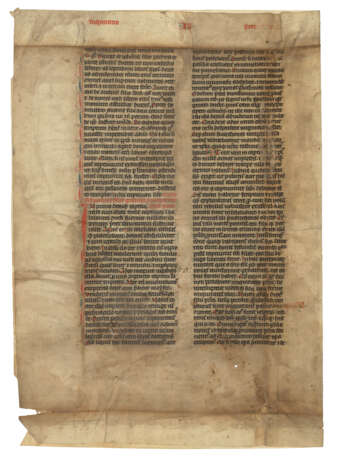ID 869493
Lot 86 | Vincent of Beauvais (d. 1264); Anoymous Parisian illuminators
Estimate value
£ 4 000 – 6 000
The Emperor Henry V in a historiated initial on a bifolium from Speculum historiale, in Latin, illuminated manuscript on vellum [France, Paris, early 14th century].
A rare example of a major historiated initial on a bifolium of a secular text, the most popular medieval encyclopaedia.
Each leaf c.370 x 263mm. Written in two columns of 50 lines (a capitula list further subdivided into two columns), the text comprising part of the end of Book 26 (chapters 130–32) and beginning of Book 27 (chapters 1–4), with a gap between them (‘et tria milia et quingentos viros […] Quod si patrum opera dimitterent et de’ and ‘|to et in ordinato […] Sed et reverentis’), the start of Book 27 with the rubric ‘De imperio Henrici quinti et carta caritatis’ and a large historiated initial, the running headings with the book number ‘L[iber] XXVI’ and headings ‘Disputatio Petri Alfunsi’ [sic] or ‘L[iber] XXVII’ and ‘Tempora Henrici quinti’ (recovered from use as a book-cover, with consequent creases and some darkening and a few later marginal inscriptions, mostly erased, the initial somewhat rubbed, but overall in fair condition)
Provenance:
Colker MS 137; acquired from Renzo Rizzi in 1968.
Illumination:
The fine initial illustrates the beginning of Book 27, and depicts Henry V, with imperial crown and sword, approached by crippled beggars, watched by a crowd, all below a gold reliquary; marginal extensions occupy three margins, incorporating a hunting-dog chasing a rabbit. Prof. Alison Stones kindly tells us that the closest comparison is in Paris, BnF, MS. lat. 4900, f.109v, which depicts the Emperor pointing out relics to cripples and other people, but that surprisingly few copies of the text have historiated initials at all, and so this is an important example. She places it with her ‘Paris, c.1300–1310 and later’ group of Speculum historiale manuscripts: Alison Stones, Gothic Manuscripts: 1260–1320, Part Two, A survey of manuscripts illuminated in France, 2 vols (London & Turnhout, 2014), II, pp. 259–62 and 266.
The Speculum historiale (Mirror of History), is a history of the world to the 1240s, forming the third part of Vicent’s Speculum maius (Great Mirror), a vast encyclopedia that attempted to encompass all forms of knowledge: the first two parts concern scientific knowledge, in the Speculum naturale (Mirror of Nature), and human affairs, in the Speculum doctrinale (Mirror of Doctrine).
| Place of origin: | France |
|---|---|
| Auction house category: | Medieval & renaissance manuscripts |
| Place of origin: | France |
|---|---|
| Auction house category: | Medieval & renaissance manuscripts |
| Address of auction |
CHRISTIE'S 8 King Street, St. James's SW1Y 6QT London United Kingdom | |
|---|---|---|
| Preview |
| |
| Phone | +44 (0)20 7839 9060 | |
| Buyer Premium | see on Website | |
| Conditions of purchase | Conditions of purchase |





